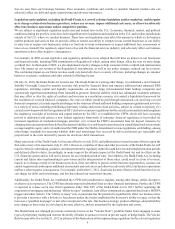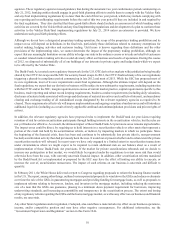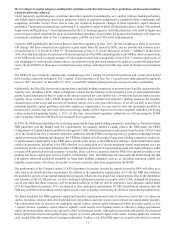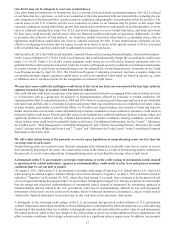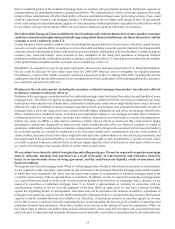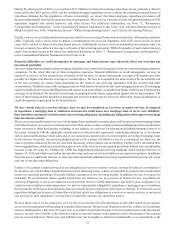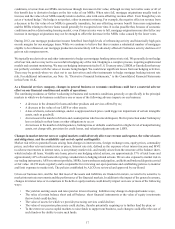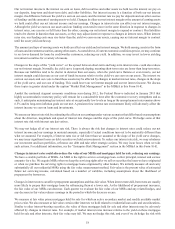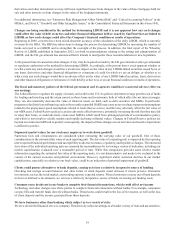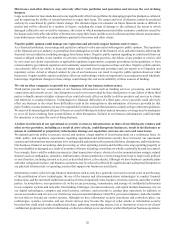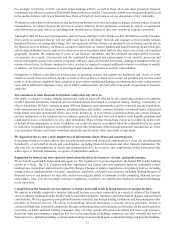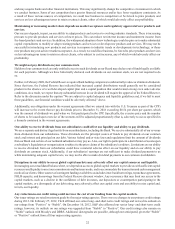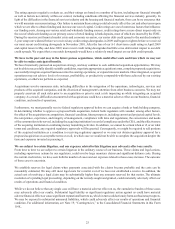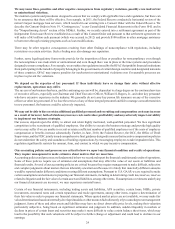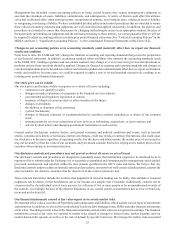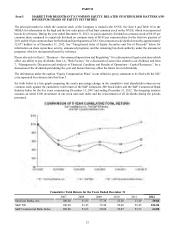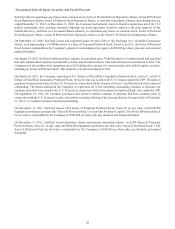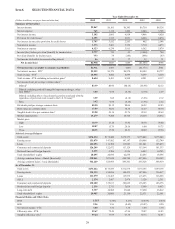SunTrust 2012 Annual Report Download - page 35
Download and view the complete annual report
Please find page 35 of the 2012 SunTrust annual report below. You can navigate through the pages in the report by either clicking on the pages listed below, or by using the keyword search tool below to find specific information within the annual report.19
derivatives and other instruments we may still incur significant losses from changes in the value of these mortgages held for
sale and other interests or from changes in the value of the hedging instruments.
For additional information, see “Enterprise Risk Management–Other Market Risk” and “Critical Accounting Policies” in the
MD&A, and Note 9, "Goodwill and Other Intangible Assets," to the Consolidated Financial Statements in this Form 10-K.
Changes are being considered in the method for determining LIBOR and it is not apparent how any such changes
could affect the value of debt securities and other financial obligations held or issued by SunTrust that are linked to
LIBOR, or how such changes could affect the Company's financial condition or results of operations.
Beginning in 2008, concerns have been raised about the accuracy of the calculation of the daily LIBOR, which is currently
overseen by the BBA. The BBA has taken steps to change the process for determining LIBOR by increasing the number of
banks surveyed to set LIBOR and to strengthen the oversight of the process. In addition, the final report of the Wheatley
Review of LIBOR, published in September 2012, set forth recommendations relating to the setting and administration of
LIBOR, and the UK government has announced that it intends to incorporate these recommendations in new legislation.
At the present time it is uncertain what changes, if any, may be required or made by the UK government or other governmental
or regulatory authorities in the method for determining LIBOR. Accordingly, at the present time it is not apparent whether or
to what extent any such changes would have an adverse impact on the value of any LIBOR-linked securities issued by us or
any loans, derivatives and other financial obligations or extensions of credit for which we are an obligor, or whether or to
what extent any such changes would have an adverse effect on the value of any LIBOR-linked securities, loans, derivatives
and other financial obligations or extensions of credit held by or due to us or on our financial condition or results of operations.
The fiscal and monetary policies of the federal government and its agencies could have a material adverse effect on
our earnings.
The Federal Reserve regulates the supply of money and credit in the U.S. Its policies determine in large part the cost of funds
for lending and investing and the return earned on those loans and investments, both of which affect the net interest margin.
They can also materially decrease the value of financial assets we hold, such as debt securities and MSRs. In particular,
programs to facilitate loan refinancing, such as the recently expanded HARP, may cause us to reevaluate repayment assumptions
related to the prepayment speed assumptions related to loans that we service, and this may adversely affect the fair value of
our MSR asset. Federal Reserve policies can also adversely affect borrowers, potentially increasing the risk that they may fail
to repay their loans, or could adversely create asset bubbles which result from prolonged periods of accommodative policy,
and which in turn result in volatile markets and rapidly declining collateral values. Changes in Federal Reserve policies are
beyond our control and difficult to predict; consequently, the impact of these changes on our activities and results of operations
is difficult to predict.
Depressed market values for our stock may require us to write down goodwill.
Numerous facts and circumstances are considered when evaluating the carrying value of our goodwill. One of those
considerations is the estimated fair value of each reporting unit. The fair value of a reporting unit is impacted by the reporting
unit's expected financial performance and susceptibility to adverse economic, regulatory, and legislative changes. The estimated
fair values of the individual reporting units are assessed for reasonableness by reviewing a variety of indicators, including our
market capitalization evaluated over a reasonable period of time. While this comparison provides some relative market
information regarding the estimated fair value of the reporting units, it is not determinative and needs to be evaluated in the
context of the current economic and political environment. However, significant and/or sustained declines in our market
capitalization, especially in relation to our book value, could be an indication of potential impairment of goodwill.
Clients could pursue alternatives to bank deposits, causing us to lose a relatively inexpensive source of funding.
Checking and savings account balances and other forms of client deposits could decrease if clients perceive alternative
investments, such as the stock market, as providing superior expected returns. When clients move money out of bank deposits
in favor of alternative investments, we can lose a relatively inexpensive source of funds, increasing our funding costs.
Consumers may decide not to use banks to complete their financial transactions, which could affect net income.
Technology and other changes now allow parties to complete financial transactions without banks. For example, consumers
can pay bills and transfer funds directly without banks. This process could result in the loss of fee income, as well as the loss
of client deposits and the income generated from those deposits.
We have businesses other than banking which subject us to a variety of risks.
We are a diversified financial services company. This diversity subjects earnings to a broader variety of risks and uncertainties.


